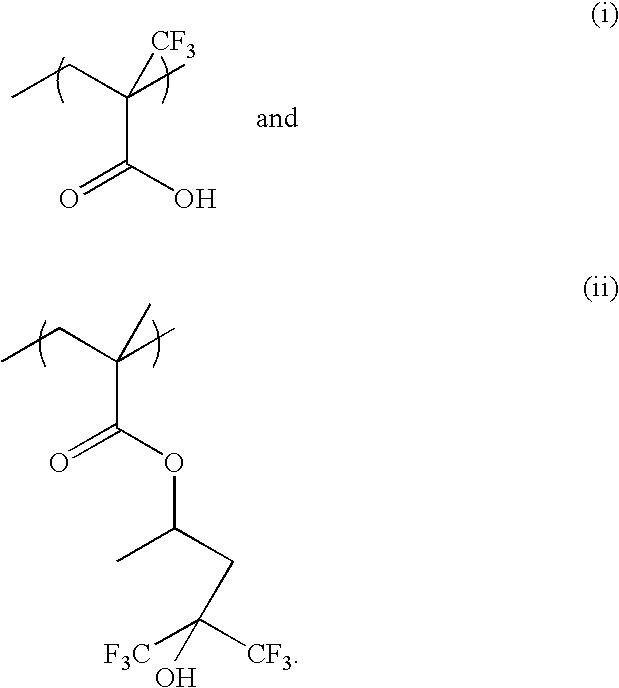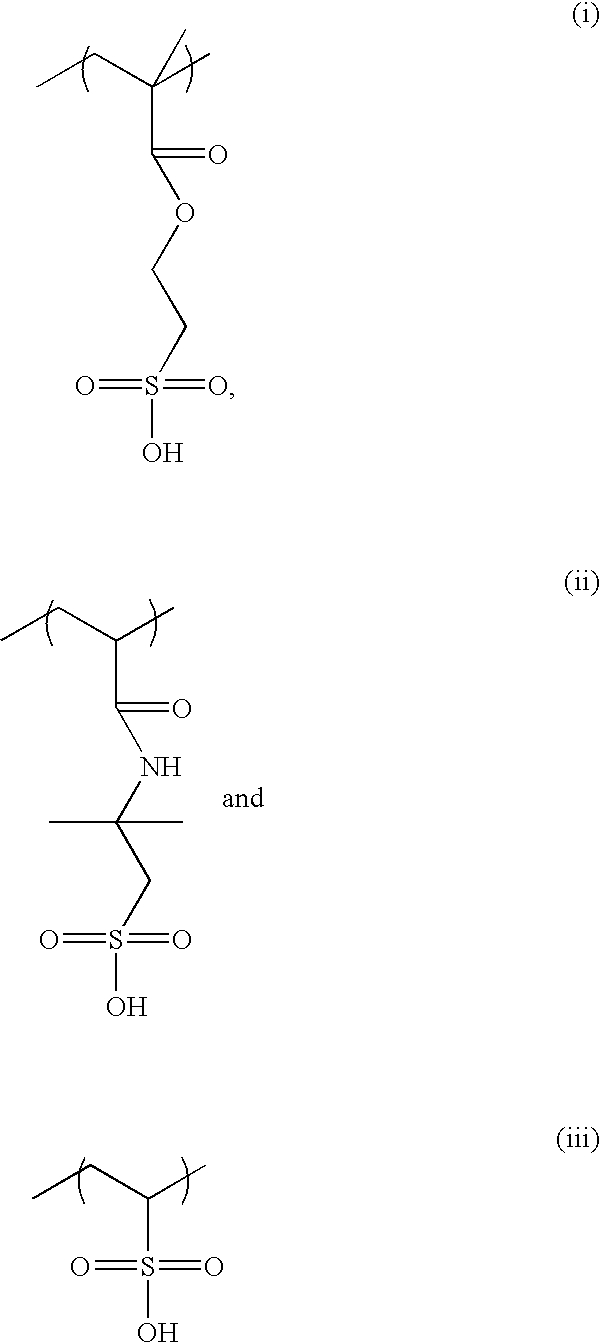Top antireflective coating composition with low refractive index at 193nm radiation wavelength
a technology of anti-reflective coating and radiation wavelength, which is applied in the field of microelectronics industry, can solve the problems of insufficient combination of optical properties and physical and chemical performance characteristics of existing commercial tarc compositions, limited resolution of resist images, and extra complication and expense of separate tarc removal steps. achieve the effect of outstanding optical and ease of us
- Summary
- Abstract
- Description
- Claims
- Application Information
AI Technical Summary
Problems solved by technology
Method used
Image
Examples
example 1
Synthesis of Copolymer of 2-vinylnaphthalene and tert-butyl acrylate (PVNTBA1 (10 / 90))
[0046] 0.77 g of 2-vinylnaphthalene, 5.77 g of tert-butyl acrylate and 0.41 g of 2,2′-azobis(2-methylpropionitrile) (AlBN) initiator were dissolved in 30 g of tetrahydrofuran (THF) and charged into a 3-neck flask. The system was then purged with N2 for 30 minutes before the temperature was raised to 70° C. The reaction was carried out under N2 overnight at 70° C. The solution was then precipitated in 1000 ml of deionized (DI) water. The precipitated solid was dissolved in ˜35 g of acetone and re-precipitated in 1000 ml of DI water. The polymer was collected and dried in vacuum oven overnight at 65° C. Yield was 81% PVNTBA1 (10 / 90) having the structure illustrated below:
example 2
Synthesis of Copolymers of 2-vinylnaphthalene and tert-butyl acrylate (PVNTBA2(20 / 80)) and (PVNTBA3(40 / 60))
[0047] Two copolymers with different ratios of 2-vinylnaphthalene and tert-butyl acrylate were synthesized using the same procedure as described in Example 1 above except for the amount of the reactants added in the reaction mixtures. For synthesizing PVNTBA2(20 / 80): 1.54 g of 2-vinylnaphthalene, 5.13 g of tert-butyl acrylate and 0.41 g of AlBN initiator were dissolved in 30 g of THF; while for PVNTBA3(40 / 60): 3.08 g of 2-vinylnaphthalene, 3.85 g of tert-butyl acrylate and 0.41 g of AlBN initiator were dissolved in 30 g of THF. The yield for PVNTBA2(20 / 80) was 84%, while PVNTBA3(40 / 60) was 65%. The structures of these polymers are illustrated below:
example 3
Optical Properties of Copolymers of 2-vinylnaphthalene and tert-butyl acrylate
[0048] Each of the polymers synthesized in Examples 1 and 2 was dissolved in propylene glycol monomethyl ether acetate (PGMEA) to obtain 5 wt. % of solids in solution. Each formulated solution was spin-coated on a silicon wafer and then baked on a hot plate at 110° C. for 60 seconds. Then n and k values were measured with VB-250 VASE Ellipsometer manufactured by J.A. Woollam Co. Inc. The measured optical properties of the film for 193 nm radiation are shown in the following table.
SamplePolymer Compositionn at 193 nmk at 193 nm1PVNTBA1(10 / 90)1.5700.0222PVNTBA2(20 / 80)1.5330.0473PVNTBA3(40 / 60)1.3910.132
PUM
| Property | Measurement | Unit |
|---|---|---|
| radiation wavelength | aaaaa | aaaaa |
| refractive index | aaaaa | aaaaa |
| refractive index | aaaaa | aaaaa |
Abstract
Description
Claims
Application Information
 Login to View More
Login to View More - R&D
- Intellectual Property
- Life Sciences
- Materials
- Tech Scout
- Unparalleled Data Quality
- Higher Quality Content
- 60% Fewer Hallucinations
Browse by: Latest US Patents, China's latest patents, Technical Efficacy Thesaurus, Application Domain, Technology Topic, Popular Technical Reports.
© 2025 PatSnap. All rights reserved.Legal|Privacy policy|Modern Slavery Act Transparency Statement|Sitemap|About US| Contact US: help@patsnap.com



